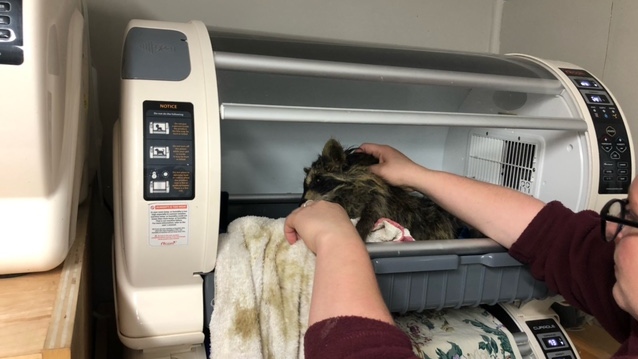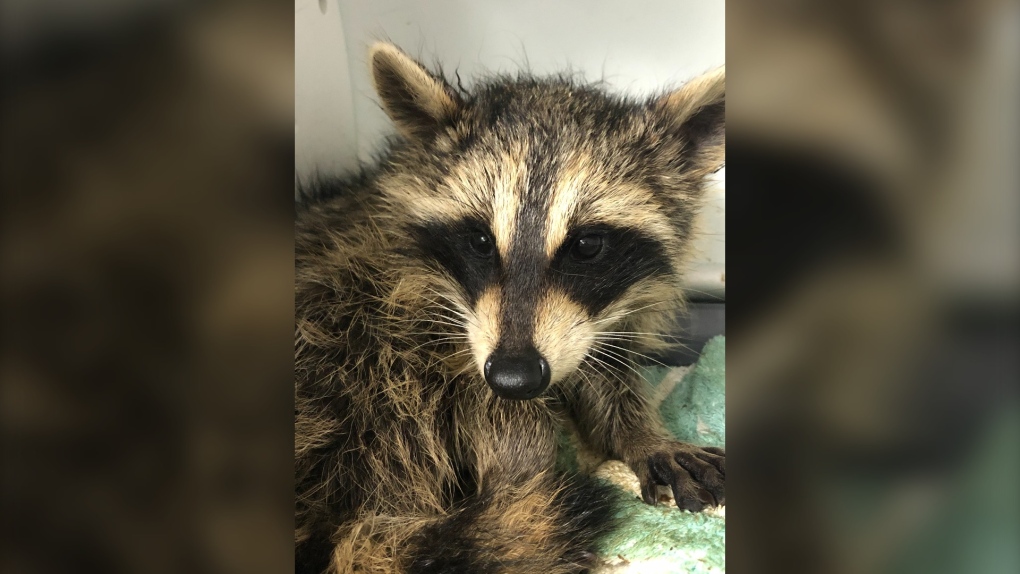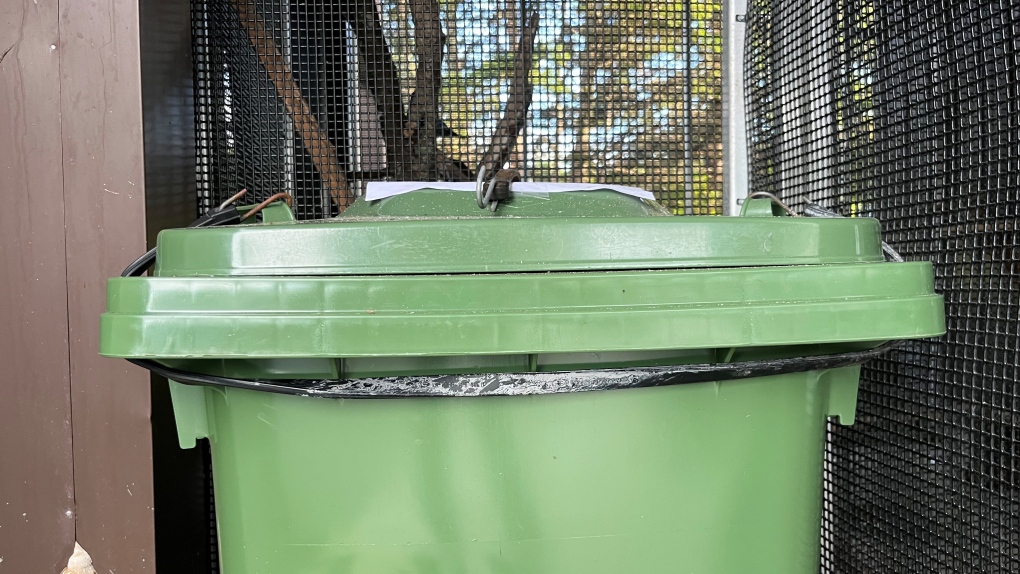Unsecured green bins can be deadly for raccoons, Hope for Wildlife warns after spike in calls
 A racoon is pictured inside a green bin. (Courtesy: Hope Swinimer)
A racoon is pictured inside a green bin. (Courtesy: Hope Swinimer)
Hope For Wildlife, a wildlife rehabilitation centre in Seaforth, N.S., is reminding people about the dangers of unsecured composing green bins for raccoons after seeing a spike in calls.
The organization issued the reminder in a Facebook post Wednesday morning, along with three photos of a small female raccoon.
 This kit is being treated with heat, oxygen and medicine after becoming stuck in a green bin. (Source: Facebook/Hope For Wildlife)
This kit is being treated with heat, oxygen and medicine after becoming stuck in a green bin. (Source: Facebook/Hope For Wildlife)
Hope Swinimer, the founder and director of Hope For Wildlife, says she was “shocked” to see a raccoon of that size.
“She’s really small,” she said during a phone interview with CTV News Wednesday. “I would guess about three months old.”
The animal came into the care of Swinimer’s team Tuesday after it became trapped inside a green bin in Lantz, N.S.
Hope For Wildlife says raccoons become trapped in green bins for several reasons, including being too small to get out. Decomposing food can also give off disorienting odours, which can cause them to become lethargic.
The centre says the raccoon featured in the social-media post struggled in eight inches of “decomposing muck” until it was found.
Swinimer says she asked the raccoon’s rescuers the last time they dumped anything in their bin.
“It was three or four days, but that doesn’t mean (the raccoon) was in there for that long,” she says, “Judging from his body condition, it was probably two or three days.”
Once arriving in Seaforth, the kit was given a bath and treated for “severe” hypothermia and is currently undergoing observation and treatment.
“(It’s) in really, really, rough shape and getting heat, oxygen and medicine,” says Swinimer. “Hasn’t come around much yet.”
 Hope Swinimer says this racoon was doing "much better" after it was found in Lantz, N.S., on Tuesday. (Courtesy: Hope Swinimer)
Hope Swinimer says this racoon was doing "much better" after it was found in Lantz, N.S., on Tuesday. (Courtesy: Hope Swinimer)
Hope For Wildlife says it has seen seen “a significant” rise in the number of calls about raccoons being stuck in green bins, with the centre receiving about three calls a day this fall.
“We’ve had 37 calls, and of those 37, 15 or 16 had to come in for care,” says Swinimer, who adds that during an average fall season she typically sees “about half” that number.
In the summer, the trapped raccoons may die in green bins from the heat and from the cold in the winter. They can also die from lack of water.
“We do lose a lot though,” she added. “Because of the stress and energy they burn.”
Hope’s team says raccoons have strong and dexterous fingers so people should secure their green bins with a tight and thick rubber bungee cord that can’t be pulled off or chewed through.
 Hope Swinimer says this photo shows how people should secure their green bins. (Courtesy: Hope Swinimer)
Hope Swinimer says this photo shows how people should secure their green bins. (Courtesy: Hope Swinimer)
At a recent Hope For Wildlife open house, more than 150 bungee cords were handed out to visitors, and Swinimer hopes people will use them.
She also expects her phone to ring a lot next month too, but for a different reason.
“When you look the statistics, November is the worse month for animals hit by cars,” she says. “Be aware at dawn and dusk while driving.”
CTVNews.ca Top Stories

Poilievre supports Israel 'proactively striking' Iranian nuclear sites to defend itself
Conservative Leader Pierre Poilievre is supporting Israel's right to defend itself against Iran following last week's ballistic missile attack, saying that right includes 'proactively striking Iranian nuclear sites and oil installations to defund the terrorist regime.'
Hurricane Milton strengthens into a Category 5 storm. Florida orders evacuations
Florida's storm-battered Gulf Coast raced against a Category 5 hurricane Monday as workers sprinted to pick up heaps of appliances and other street debris left over from Helene two weeks ago and highways were clogged with people fleeing ahead of the storm.
How is Canada protecting customers buying from foreign e-commerce sites like Temu and Shein?
As U.S. regulators push for an investigation into what they call 'deadly baby and toddler products' from foreign e-commerce sites, health officials in Canada say they haven't determined whether any laws or regulations have been broken.
Most fathers say they spend equal time caring for their child — fewer mothers agree, survey says
When it comes to raising a child, the majority of fathers say they share tasks equally, but fewer mothers tend to say the same thing, according to a Statistics Canada survey.
'Selfish billionaire': Chip Wilson's mansion vandalized after political sign erected outside
Days after a political sign was erected outside Lululemon founder Chip Wilson's Vancouver mansion, the waterfront property has been vandalized with graffiti.
'Feel free to get naked,' witness testifies Toronto councillor told her during 'networking' weekend
Toronto Coun. Michael Thompson 'forced himself on' a woman who awoke to find him standing over her after she fell asleep drunk, the Crown alleged Monday, as the five-day sexual assault trial of the six-term politician began in Bracebridge, Ont.
Is Disney World still open as Hurricane Milton strengthens to a Category 5?
Despite Hurricane Milton evolving into a Category 5 storm, Walt Disney World Resort remains open to the public and will operate as normal. However, the park announced Monday a few closures in an abundance of caution.
Disgraced former Winnipeg football coach sentenced to 20 years in prison for sexual assault
A disgraced Winnipeg high school football coach convicted of sexual assault and luring will spend 20 years behind bars.
Two people injured in apparent road rage incident, shooting in Toronto
Two people are in hospital after they were chased and shot at in what appears to be an act of road rage before eventually flipping their car while trying to escape, police say.


































